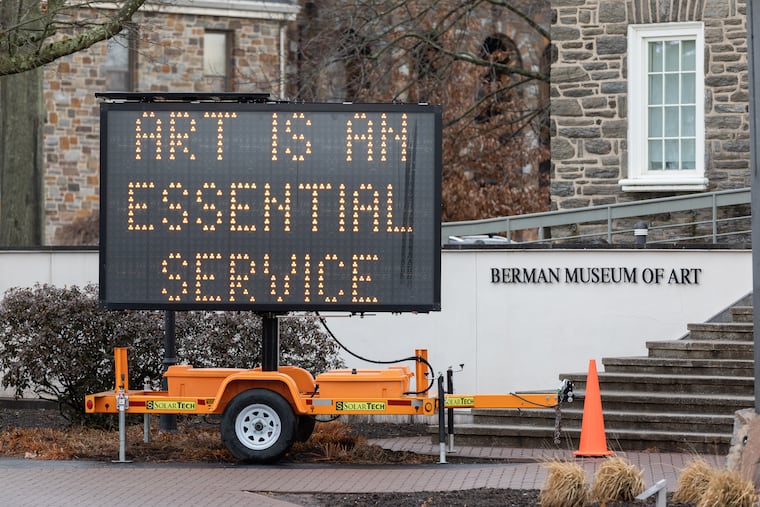Berman Museum of Art’s new show puts in the work
Titled “Essential Work,” the show explores labor and what forms of it are seen as "essential"

Four new shows at the Berman Museum of Art bring together the work of leading contemporary artists to a century-old fieldstone building on the campus of Ursinus College. The museum, run by a staff of six, is only an hour’s drive from Center City.
The main gallery’s show, “Essential Work,” features seven artists who explore the elusive meaning of labor, workers, and what society deems worthy.
The show pulls its title from pandemic parlance, but this isn’t art about COVID-19. But curator Deborah Barkun did find inspiration in the pandemic’s erosion of boundaries — between public and private, home and work, essential and optional.
There are no framed paintings here. Instead, 25 paintbrushes hang on a white wall, each with a tiny portrait of a woman painted on the tip of the handle. For 20 years, California-based painter Rebecca Szeto has inscribed these miniature faces onto the industrial brushes she uses on commercial painting jobs. The portraits feature famous women — like author Mary Shelley — and working women whose names have been lost to history, a nod to her Chinese grandmother’s time in a San Francisco sweatshop.
Working women also star in a quiet, curious series of photographs by Ruth Prieto Arenas. These are Mexican immigrant women who work at a New York City restaurant for “lonely men.” Clients essentially pay the women to flirt with them for the duration of a beer. There are scenes from the bleary-looking bar: awkward, cramped, and compositionally vague. And then, portraits of the women at home: lovely and wistful, sometimes with toddlers in view.
Across the room, factory footage loops on five flat-screen TVs. But the workers have vanished. Philadelphia artist Amy Hicks painstakingly Photoshopped them out, leaving boxes that levitate and cabinets that fling themselves open. On a bigger screen to the right, we see the transplanted laborers — just bodies in a black void, drifting and spinning. It’s a mesmerizing dance, titled Imaginary Labor, graceful and free in one moment, robotic and Sisyphean the next.
New to the museum world is the eco-conscious Nicole McLaughlin, who upcycles found objects into Gen-Z outfits. On her 800K followers-strong Instagram, you’ll see pants stitched from Chipotle napkins and a beanie made from flattened tennis balls. In a profile in The Cut, she relates her process to a racoon: “They find everything they need in the trash.”
Tool Kit Bikini, one of McLaughlin’s two pieces in this show, is a reclining swimsuit cut from Carhartt fabric and laid flat on a white surface, the pockets stuffed with screwdrivers, wrenches, and superglue. A sort of reverse nude — all clothes, no body.
Voice, a cluster of machine-powered picket signs by Fernando Orellana, is the storm in the middle of the calm. The signs activate (very loudly!) when a visitor clicks the “Resist Here” button. Seemingly a commentary on the automation of protest, keyboard activism, and retweeted manifestos, it’s also a reminder that protest should be loud, aggressive, and annoying.
For a show on a college campus, “Essential Work” is refreshingly free of academic blather, and while it hints at the ugly, it’s rarely not pretty.
The four spring shows open Feb. 9. Free and are open to the public from 5-7 p.m. “Essential Work” runs through April 2. www.ursinus.edu/live/profiles/6901-essential-work